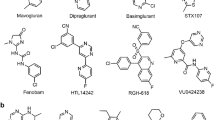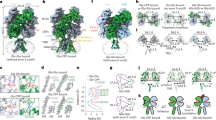Abstract
The antagonist-bound conformation of the NR2A and NR2B subunits of N-methyl-D-aspartate (NMDA) ionotropic glutamate receptor are modeled using the crystal structure of the DCKA (5,7-dichloro-kynurenic acid)-bound form of the NR1 subunit ligand-binding core (S1S2). Five different competitive NMDA receptor antagonists [(1) DL-AP5; (2) DL-AP7; (3) CGP-37847; (4) CGP 39551; (5) (RS)-CPP] have been docked into both NR2A and NR2B subunits. Experimental studies report NR2A and NR2B subunits having dissimilar interactions and affinities towards the antagonists. However, the molecular mechanism of this difference remains unexplored. The distinctive features in the antagonist’s interaction with these two different but closely related (~80% sequence identity at this region) subunits are analyzed from the patterns of their hydrogen bonding. The regions directly involved in the antagonist binding have been classified into seven different interaction sites. Two conserved hydrophilic pockets located at both the S1 and S2 domains are found to be crucial for antagonist binding. The positively charged (Lys) residues present at the second interaction site and the invariant residue (Arg) located at the fourth interaction site are seen to influence ligand binding. The geometry of the binding pockets of NR2A and NR2B subunits have been determined from the distance between the C-α atoms in the residues interacting with the ligands. The binding pockets are found to be different for NR2A and NR2B. There are gross dissimilarities in competitive antagonist binding between these two subunits. The binding pocket geometry identified in this study may have the potential for future development of selective antagonists for the NR2A or NR2B subunit.
Figure The figure shows the interactions of Drug-E with the NR2A subunit of the NMDA receptor. The amino acids shown here are within 4Å radius of drug. Hydrogen bonds between the drug and receptor are marked in green dotted lines. Drugs are rendered in cpk (ball and stick) and amino acids are shown in blue color (lines).








Similar content being viewed by others
References
McBain CJ, Mayer ML (1994) Physiol Rev 74:723–760
Collingridge GL, Bliss TV (1995) Trends Neurosci 18:54–56
Choi DW, Koh JY, Peters SJ (1988) J Neurosci 8:185–196
Nakanishi S (1992) Science 258:597–603
Hollmann M, Maron C, Heinemann S (1994) Neuron 13:1331–1343
Rigby M, Le Bourdelles B, Heavens RP, Kelly S, Smith D, Butler A, Hammans R, Hills R, Xuereb JH, Hill RG, Whiting PJ, Sirinathsinghji DJ (1996) Neuroscience 73:429–447
Wenzel A, Fritschy JM, Mohler H, Benke D (1997) J Neurochem 68:469–478
Monyer H, Burnashev N, Laurie DJ, Sakmann B, Seeburg PH (1994) Neuron 12:529–540
Laube B, Kuhse J, Betz H (1998) J Neurosci 18:2954–2961
Benveniste M, Mayer ML (1991) Br J Pharmacol 104:207–221
Clements JD, Westbrook GL (1991) Neuron 7:605–613
Hirai H, Kirsch J, Laube B, Betz H, Kuhse J (1996) Proc Natl Acad Sci USA 93:6031–6036
Laube B, Hirai H, Sturgess M, Betz H, Kuhse J (1997) Neuron 18:493–503
Anson LC, Chen PE, Wyllie DJ, Colquhoun D, Schoepfer R (1998) J Neurosci 18:581–589
Hawkins LM, Chazot PL, Stephenson FA (1999) J Biol Chem 274:272–118
Chazot PL (2000) Curr Opin Investig Drugs 1:370–374
Chenard BL, Menniti FS (1999) Curr Pharm Des 5:381–404
Priestley T, Laughton P, Macaulay AJ, Hill RG, Kemp JA (1996) Neuropharmacology 35:1573–1581
Priestley T, Laughton P, Myers J, Le Bourdelles B, Kerby J, Whiting PJ (1995) Mol Pharmacol 48:841–848
Buller AL, Monaghan DT (1997) Eur J Pharmacol 320:87–94
Feng B, Tse HW, Skifter DA, Morley R, Jane DE, Monaghan DT (2004) Br J Pharmacol 141:508–516
Monaghan DT, Olverman HJ, Nguyen L, Watkins JC, Cotman CW (1988) Proc Natl Acad Sci USA 85:9836–9840
Ortwine DF, Malone TC, Bigge CF, Drummond JT, Humblet C, Johnson G, Pinter GW (1992) J Med Chem 35:1345–1370
Stern-Bach Y, Bettler B, Hartley M, Sheppard PO, O’Hara PJ, Heinemann SF (1994) Neuron 13:1345–1357
Armstrong N, Gouaux E (2000) Neuron 28:165–181
Furukawa H, Gouaux E (2003 ) EMBO J 22:2873–2885
Oh BH, Pandit J, Kang CH, Nikaido K, Gokcen S, Ames GF, Kim SH (1993) J Biol Chem 268:11348–11355
Jin R, Banke TG, Mayer ML, Traynelis SF, Gouaux E (2003) Nat Neurosci 6:803–810
Chohan KK, Wo ZG, Oswald RE (2000) J Mol Mod 6:16–25
Tikhonova IG, Baskin II, Palyulin VA, Zefirov NS, Bachurin SO (2002) J Med Chem 45:3836–3843
Foucaud B, Laube B, Schemm R, Kreimeyer A, Goeldner M, Betz H (2003) J Biol Chem 278:24011–24017
Laube B, Schemm R, Betz H (2004) Neuropharmacology 47:994–1007
Sanchez R, Sali A (1997) Curr Opin Struct Biol 2:206–214
Bi H, Sze CI (2002) J Neurol Sci 200:11–18
Leeson PD, Carling RW, Moore KW, Moseley AM, Smith JD, Stevenson G, Chan T, Baker R, Foster AC, Grimwood S (1992) J Med Chem 35:1954–1968
Woodward RM, Huettner JE, Guastella J, Keana JF, Weber E (1995) Mol Pharmacol 47:568–581
Christie JM, Jane DE, Monaghan DT (2000) J Pharmacol Exp Ther 292:1169–1174
Buller AL, Larson HC, Schneider BE, Beaton JA, Morrisett RA, Monaghan DT (1994) J Neurosci 14:5471–5484
Grimwood S, Gilbert E, Ragan CI, Hutson PH (1996) J Neurochem 66:2589–2595
Kendrick SJ, Lynch DR, Pritchett DB (1996) J Neurochem 67:608–616
Altschul SF, Madden TL, Schaffer AA, Zhang J, Zhang Z, Miller W, Lipman DJ (1997) Nucleic Acids Res 25:3389–3402
Rost B, Sander C, Rost B, Sander C (1993) J Mol Biol 232:584–599
Thompson JD, Higgins DG, Gibson TJ (1994) Nucleic Acids Res 22:4673–4680
Sali A, Blundell TL (1993) J Mol Biol 234:779–815
Luthy R, Bowie JU, Eisenberg D (1992) Nature 356:83–85
Laskowski RA, MacArthur MW, Moss DS, Thornton JM (1993) J Appl Crystal 26:283–291
All tools utilized herein were accessed and utilized as implemented in InsightII-97.5, Accelrys (www.accelrys.com)
Kleywegt GJ, Jones TA (1997) Methods in Enzymology 277:525–545
Bohm HJ (1992) J Comput Aided Mol Des 6:593–606
Bohm HJ (1994) J Comput Aided Mol Des 3:243–256
Blaise M, Sowdhamini R, Rao MRP, Pradhan N (2004) J Mol Model (in press)
Evans RH, Francis AA, Jones AW, Smith DA, Watkins JC (1982) Br J Pharmacol 75:65–75
Laurie DJ, Seeburg PH (1994) Eur J Pharmacol 268:335–345
Pang A, Arinaminpathy Y, Sansom MS, Biggin PC (2003) FEBS Lett 550:168–174
Arinaminpathy Y, Sansom MS, Biggin PC (2002) Biophys J 82:676–683
Acknowledgment
The authors acknowledge the assistance of Mr. R. Rajagopal in the preparation of the manuscript.
Author information
Authors and Affiliations
Corresponding author
Rights and permissions
About this article
Cite this article
Blaise, MC., Sowdhamini, R. & Pradhan, N. Comparative analysis of different competitive antagonists interaction with NR2A and NR2B subunits of N-methyl-D-aspartate (NMDA) ionotropic glutamate receptor. J Mol Model 11, 489–502 (2005). https://doi.org/10.1007/s00894-005-0258-5
Received:
Accepted:
Published:
Issue Date:
DOI: https://doi.org/10.1007/s00894-005-0258-5




